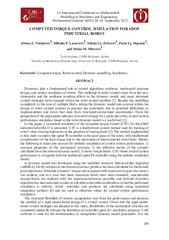| dc.creator | Vidaković, Jelena | |
| dc.creator | Lazarević, Mihailo | |
| dc.creator | Živković, Nikola Lj. | |
| dc.creator | Stepanić, Pavle | |
| dc.creator | Mitrović, Stefan | |
| dc.date.accessioned | 2023-01-28T16:34:11Z | |
| dc.date.available | 2023-01-28T16:34:11Z | |
| dc.date.issued | 2022 | |
| dc.identifier.isbn | 978-86-6060-127-0 | |
| dc.identifier.uri | https://machinery.mas.bg.ac.rs/handle/123456789/4081 | |
| dc.description.abstract | Dynamics play a fundamental role in control algorithms synthesis, mechanical structure
design, and motion simulation of robots. The challenge in robot control arises from the nonstationarity and the nonlinear coupling effects in the dynamic model, and many advanced
control strategies have emerged within the robot control problem [1]. Besides the modelling
complexity in the case of multiple DoFs, taking the dynamic model into account within the
design of robot control systems in practice has drawbacks due to potential difficulties in
implementation and errors that stem from structured/unstructured uncertainties. From the
perspective of the appropriate selection of control strategy for a particular robot, control system
performance simulation based on the robot dynamic model is a useful tool [2].
In this paper, a numerical simulation of the computed torque control (CTC) for the 6DoF
industrial robot RL15 is presented. CTC is a feedforward control method used for tracking of
robot’s time-varying trajectories in the presence of varying loads [3]. The method implemented
in this study considers the speed PI controller in the joint space of the robot, with feedforward
compensation of the load torque due to the movement of interconnected robot links. Herein,
the following is taken into account for realistic simulation of control system performance: 1)
resonant properties of the mechanical structure; 2) the effective inertia of the actuator
calculated from the inverse dynamic model; 3) motor torque limits. CTC-based control system
performance is compared with the traditional speed PI controller using the realistic simulation
model.
A dynamic model was developed using the modified recursive Newton-Euler algorithm
(mRNEA). Firstly solution to the inverse dynamics problem has been calculated for the desired
joint trajectories. Obtained actuators’ torques are compared with maximum torques that motors
can achieve, and in a case that these maximum levels have been exceeded, unachievable
torques/forces are replaced with the maximum/minimum possible, and forward dynamics
algorithm has been executed in order to calculate achievable accelerations so that the performed
simulation is realistic. Joints’ velocities and positions are calculated using numerical
integration methods [4] and are used as reference values for control system performance
simulation.
The structural flexibility of robotic manipulators may limit the performance and decrease
the stability of a rigid model-based design of a control system. Given that the rigid modelbased
control strategies are adopted in this study, flexibilities of the mechanical structure are
considered indirectly through the limitation of controller gains for simulation purposes. CAE
software is used for the determination of manipulator dynamic model parameters. For the
developed CAD model of the RL15 robot, the lowest natural frequency of the manipulator is
determined in CAE software and compared with simulated control system bandwidths defined
by controller gains and the effective inertia obtained from numerical simulations of the dynamic model and inertia of employed motors and its gearboxes.
Control system performance simulation has been performed in Simulink software.
Controller gains are selected for the LTI-model with the highest load, i.e. the maximum value
of effective inertia. Dynamic saturation that takes into account motor possibilities depending
on the current robot motion and load has been applied at the controller output. Simulation of the designed control techniques is useful within the appropriate choice of the control strategy regarding achieving a compromise between the complexity of the controller development and its implementation on one side and prospective benefits obtained with controller implementation. Practical implementation possibilities are discussed within the paper. | sr |
| dc.language.iso | en | sr |
| dc.publisher | Univerzitet u Beogradu, Mašinski fakultet | sr |
| dc.relation | info:eu-repo/grantAgreement/MESTD/inst-2020/200105/RS// | sr |
| dc.relation | info:eu-repo/grantAgreement/MESTD/inst-2020/200066/RS// | sr |
| dc.rights | openAccess | sr |
| dc.rights.uri | https://creativecommons.org/share-your-work/public-domain/cc0/ | |
| dc.source | Book of abstracts: 1st International Conference on Mathematical Modelling in Mechanics and Engineering Mathematical Institute SANU, 08-10. September, 2022. | sr |
| dc.subject | Computed torque | sr |
| dc.subject | Robot control | sr |
| dc.subject | Dynamic modelling | sr |
| dc.subject | Simulation | sr |
| dc.title | Computed torque control simulation for 6DOF industrial robot | sr |
| dc.type | conferenceObject | sr |
| dc.rights.license | BY-NC-ND | sr |
| dc.citation.epage | 110 | |
| dc.citation.rank | 34 | |
| dc.citation.spage | 109 | |
| dc.identifier.fulltext | http://machinery.mas.bg.ac.rs/bitstream/id/9543/JVidakovic____ICME2022.pdf | |
| dc.identifier.rcub | https://hdl.handle.net/21.15107/rcub_machinery_4081 | |
| dc.type.version | publishedVersion | sr |


